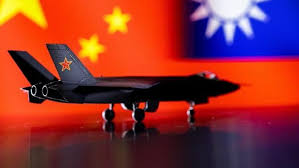The Taiwan Strait has been witnessing escalating tensions, with Taiwan’s Ministry of National Defense (MND) reporting significant military activities near its territorial waters. On July 25, the MND detected a notable incursion by the People’s Liberation Army (PLA), consisting of 25 military aircraft and four naval vessels. This incident raised serious concerns in Taiwan, prompting the Republic of China (R.O.C.) Armed Forces to deploy a swift and comprehensive response to safeguard their territorial integrity and security.
Table of Contents
Detection of PLA Military Activities – Aircraft Identification
According to a report by Taiwan News, between 6 am on Monday, July 24, and 6 am on Tuesday, July 25, the MND reported tracking 25 Chinese military aircraft and four naval vessels in the vicinity of Taiwan. Of these aircraft, 10 were detected within Taiwan’s air defense identification zone (ADIZ), signaling a direct intrusion into the island’s sovereign airspace.
The identified PLA aircraft included four Shenyang J-16 combat jets, two Shenyang J-11 fighter jets, one KJ-500 airborne early warning and control plane, one Shaanxi Y-8 reconnaissance aircraft, and one CH-4 reconnaissance drone. Additionally, one TB-001 reconnaissance drone crossed the median line of the Taiwan Strait, flying along the southern part of Taiwan’s ADIZ, as confirmed by the MND.
Taiwan’s Proactive Response
The presence of such a significant number of PLA military assets near its borders prompted Taiwan to act promptly. The R.O.C. Armed Forces immediately initiated their Combat Air Patrol (CAP) aircraft, Naval vessels, and land-based missile systems in response to the situation. By deploying these defensive measures, Taiwan aimed to closely monitor the PLA’s activities and demonstrate its readiness to protect its territorial sovereignty and security.
The deployment of Taiwan’s own aircraft, naval ships, and missile systems in the southwest corner of the ADIZ, where the PLA aircraft were concentrated, underscored Taiwan’s commitment to maintaining a vigilant defense posture in the face of potential threats.

Continued Escalation and Ongoing Vigilance
The incident on July 25 was not an isolated event. On Saturday, Taiwan’s MND reported an even larger movement of PLA military assets, with 37 Chinese military aircraft and seven naval vessels tracked over a two-day period, as reported by Taiwan News.
Disturbingly, among the 37 detected PLA aircraft, 22 crossed the median line of the Taiwan Strait or entered various sections of Taiwan’s ADIZ. This further heightened tensions in the region and emphasized the importance of Taiwan’s ongoing vigilance in safeguarding its security amid increasing military movements.
Taiwan’s Resolve to Defend Sovereignty
The recurring incursions by PLA aircraft and naval vessels have become a growing concern for Taiwan. The island nation faces a complex geopolitical landscape, and these military activities add to the already existing tensions in the region.
In response to these potential threats, Taiwan’s armed forces have shown unwavering resolve in defending their sovereignty. By taking immediate action to deploy CAP aircraft, Naval vessels, and land-based missile systems, Taiwan’s military demonstrated its readiness to respond effectively and protect its territorial integrity.
Conclusion
The events on July 25, along with the previous incident of July 24-25, highlight the escalating tensions in the Taiwan Strait. Taiwan’s Ministry of National Defense’s detection of significant PLA military activities has put the region on edge. The deployment of 25 Chinese military aircraft and four naval vessels near Taiwan’s borders prompted a swift and comprehensive response from Taiwan’s R.O.C. Armed Forces.
With the continued escalation of military movements, Taiwan’s armed forces remain on high alert, ensuring that any potential threats to its territorial sovereignty and security are promptly addressed. The situation underscores the delicate and tense nature of the Taiwan Strait and the importance of maintaining vigilance and preparedness to safeguard peace and stability in the region.













